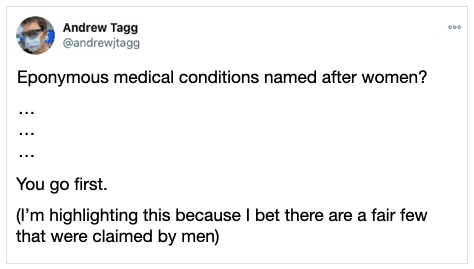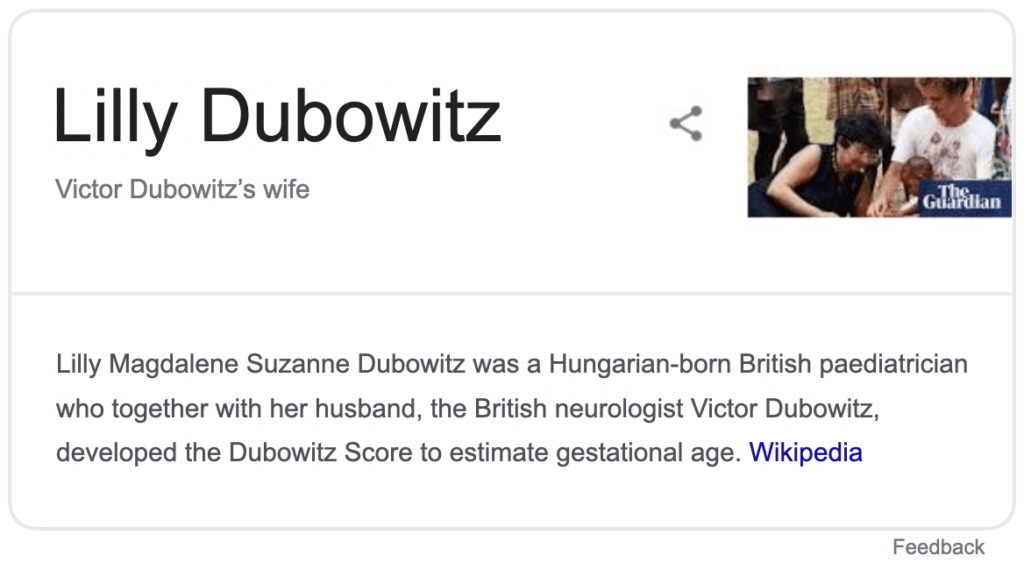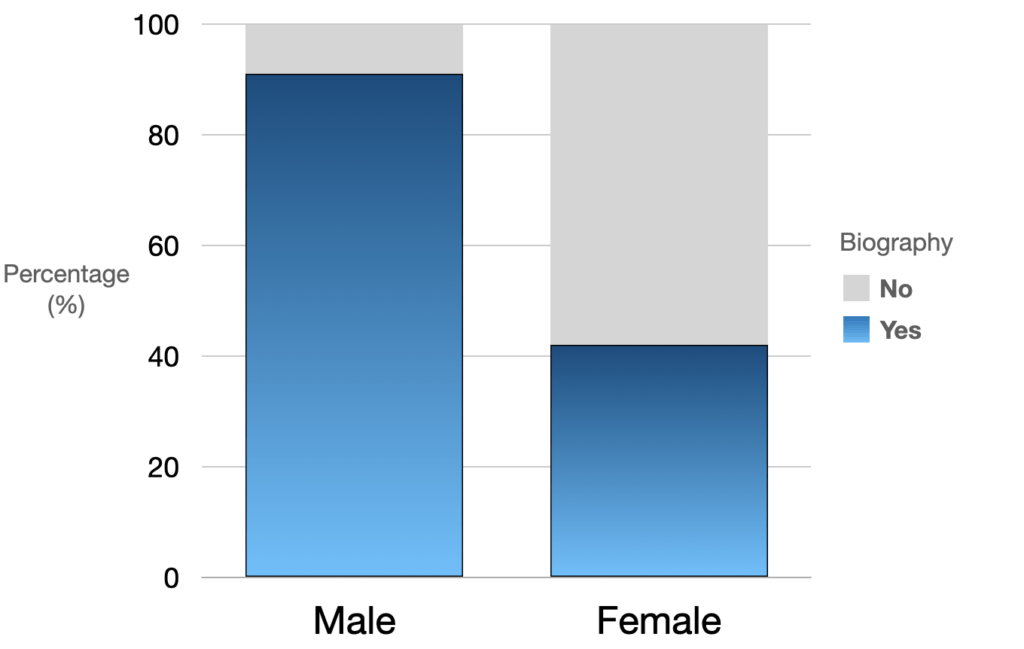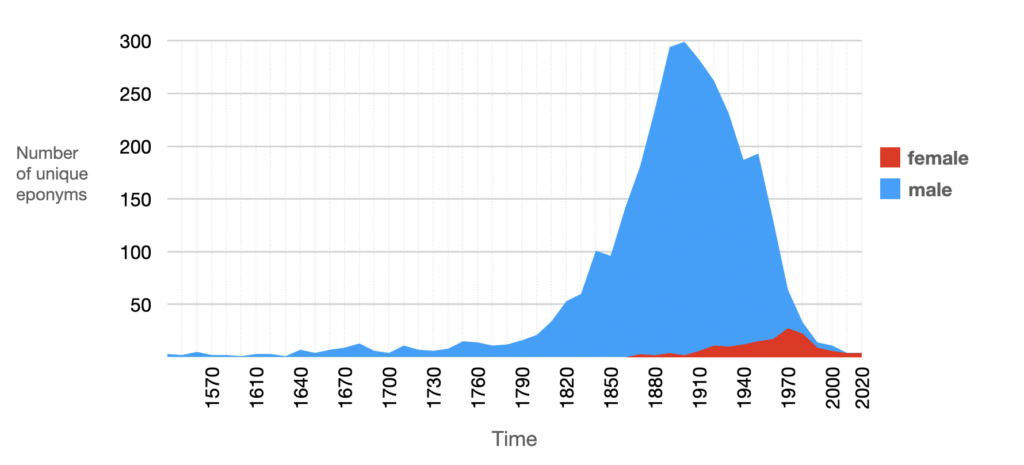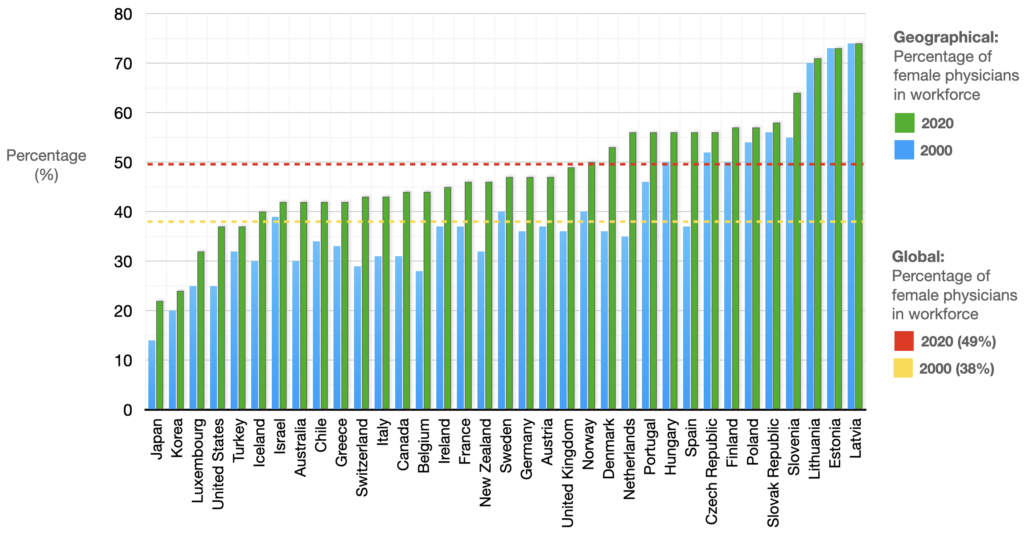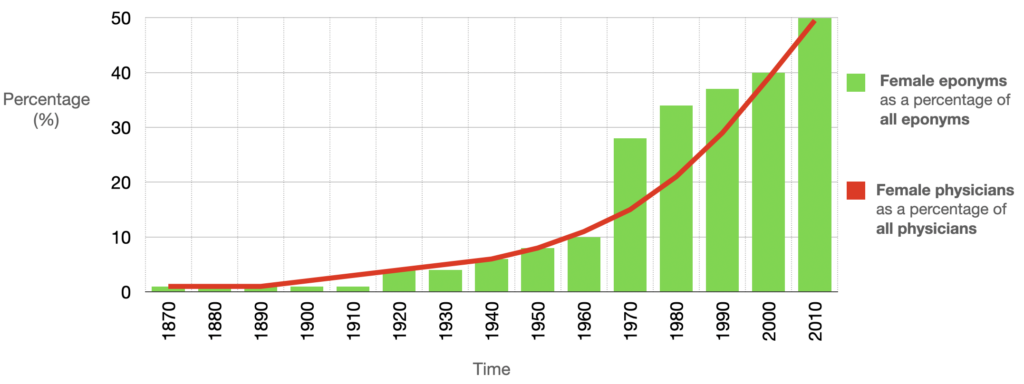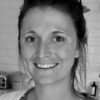Where are all the Women?
It’s time for another deep dive into eponymythology, although on this occasion it is through the roiling ocean of gender imbalance. A recent tweet in the #FOAMed community questioned the audience’s ability to identify just three female medical pioneers who had been honoured with the distinction of eponymous attribution.
The results were telling.
The thread of comments following the tweet managed to identify only 45 female eponyms. A mistake, surely. Of the thousands of eponymous terms in use, how could there be so few attributed to females?
Following this, we analysed the lists of eponyms hosted on the popular online resource, WhoNamedIt? Their alphabetical list of women eponyms boasts 131 entries. However, on closer inspection only 80 (62%) of the entries were associated with eponymous terms which included the female eponym; and of these, only 41 (31%) had a formal biography.
Further research online revealed a similar story. Even females associated with widely used eponymous terms had little to no recorded biographical information in comparison to their male counterparts. For example, Lilly Dubowitz, a paediatric neurologist who developed the Dubowitz Score with her husband Victor, is deserving only of a property based tagline as “Victor Dubowitz’s wife“.
It seemed an obvious hypothesis to investigate: Women are underrepresented in the realm of medical eponyms. Once that could be proven, a biographical database of these female pioneers would be the next goal.
Table of Contents
Introduction and Background
The use of eponyms in the field of medicine has been commonplace for centuries. There is ongoing debate regarding the accuracy, effectiveness, and, more recently, cultural appropriateness of the use of eponyms, but, for the moment, they remain ingrained in medical communication.
The majority of eponymous terms were characterised prior to women being formally allowed to practice medicine. By the time women were joining their male counterparts in medicine, the period of decline of granting eponyms had begun. Eponymous terms had given way to descriptive nomenclature.
Although most eponyms now have an approved and accepted modern alternative, many clinicians continue to utilise and teach eponymous terms in their daily practice, and as they remain historically relevant, it is important to identify and celebrate the distinguished women who characterised syndromes and other medical terms that bear their names, the way we do their male peers.
There is properly no History, only Biography.
Ralph Waldo Emerson, Essay 1: History, 1841
Definitions
For the purposes of this review we used the following definitions.
- Eponym: person after whom the disease, syndrome or sign is named e.g. Jacqueline Noonan
- Eponymous term: the disease, syndrome or sign e.g. Noonan syndrome
Aims
- Create a comprehensive database of eponymous terms and their related eponyms
- Highlight those eponyms identifying as female and confirm a related eponymous term
- Create a biographical database of female eponyms
Method
We interrogated our offline database of eponymous terms used for signs, syndromes, conditions, procedures, anatomical structures and classification systems compiled from textbook and online sources. We identified 7221 eponymous terms and 3504 eponyms, an average of 2 terms per author.
The year of the original publication relating to the eponymous term as well as the country of birth, sex, maiden name, marital name, occupation and date of birth/death of the eponym (author) were recorded. Resources used to interrogate the data included PubMed, National Library of Medicine, HathiTrust Digital Library, Wikipedia, WhoNamedIt?, Newspapers, Ancestry, and the Internet Archive.
Where no biographic source could be readily identified, we contacted affiliated universities, research groups and specialists to obtain further information.
Eponymous terms containing the name of at least one female eponym were extracted for further evaluation. Where an eponym has more than one associated eponymous term only the eponym and the earliest affiliated eponymous term was recorded for analysis.
Results of the search were compiled in an offline database and graphical analysis was used to compare male and female eponyms over time. Biographies for the male and female eponyms were compiled and eponymous terms defined with contextual bibliographic material.
Results
3504 eponyms were identified. Of these, there were 3374 (96%) male eponyms and 130 (4%) female eponyms.
Eponymous terms
- 130 female eponyms shared 156 eponymous terms, an average of 1.2 terms per author. The average number of eponymous terms per male author was 2.2 (7065/3374).
- The average date of publication of an eponyms first eponymous term was 1972 for females and 1891 for males.
Biographic data
- 32% of female eponyms are still alive compared to 5% of male eponyms. Of those deceased the average year of birth (1907) and death (1982) for females is more recent than their male counterparts (1856/1919)
- Only 43% of female eponyms had formal journal obituary or Wikipedia profile or other online biography; compared with 91% of males
- Female eponyms hail from 27 different countries, but were very Americo-centric with the United States (50%), England (9%), Germany (8%), and Canada (6%) making up the majority. Male eponyms, on the other hand, were distinctly more European: with Germany making up 19%, France 16%, England 15%, and the United States 10%; almost certainly reflecting the power shifts in Empires over time.
- The flavour of specialties is also unique, with female eponyms comprising geneticists, paediatricians and pathologists. The men had a preponderance of anatomists, surgeons, neurologists, psychiatrists, physicians and physiologists.
| Male | Female | |
|---|---|---|
| Eponymous term per eponym | 2.2 | 1.2 |
| Still alive | 5% (180) | 32% (42) |
| Average Year of birth | 1856 | 1907 |
| Average Year of death | 1919 | 1982 |
| Average Year of publication | 1891 | 1972 |
| Journal Article / Obituary | 59% (1976) | 22% (28) |
| WhoNamedIt Profile | 92% (3102) | 32% (41) |
| Wikipedia Profile | 90% (3020) | 43% (56) |
The other relevant findings were the comparison of women in the global workforce, with the rise and fall of eponyms over time.
The peak of eponymous attribution was in the late 1800s and early 1900s with eponymous terms often being used as placeholders with the exact nature of conditions not yet understood. With better classification systems, enhanced knowledge of pathogenesis, improved global nomenclature, and a more rigorous approach to naming systems – eponymous attribution has seen a sharp decline.
In 1910 female physicians made up 1% of the medical workforce. The most rapid rate of growth has been in the last 30 years from 29% in 1990, to 38% in 2000 and 49% in 2020.
The percentage of female physician representation within the medical workforce closely matches the rate of percentage growth of eponymous terms attributed to women.
Discussion
The hypothesis, that women are underrepresented in the medical realm of eponyms, does not hold up, despite how it appears at first glance. Women achieving parity with men in the global medical workforce is relatively recent. The golden age of eponymizing was over way before this equality was reached. The peak of eponymous attribution was in the late 1800s and early 1900s, so as a proportion of women in medicine at the time, there was reasonable representation. Women never got the chance to catch up. Where there is a staggering gender mismatch, however, is in the biographical evidence available to us of these remarkable women, who, by their very nature were trailblazers.
Why should we care about this anachronistic slice of medicine? Well, we all still use eponyms. They bring colour and history to medicine. They have hidden, and often extraordinary narratives that lie beneath them: our heritage, our medical ancestry. Eponyms are given to honour such souls, the shoulders of giants upon which we sit and practice today. We know their stories through their collective biographies. The clear proportional lack of biographical data on the female eponyms, however, tarnishes this tradition.
One may argue that this is merely a historical issue, done and dusted, however we still do not have gender equity by many metrics today, even in the presence of equal (or greater) medical admission numbers. Unless we recognise the inadequacies of the past, it is difficult to progress soundly into the future.
Eponyms have other shadows. The bestowal and use of eponyms was also a little random, inconsistent, idiosyncratic, and heavily influenced by local geography and culture. Sometimes there were less than truthful accounts of how diseases were discovered; evidence being less obligatory back in the day. There is also the element of ‘ownership’, particularly of body parts. Nowhere is that more evident than in the pelvis, where you can’t round a corner without crashing into a part with the name of some long-dead man and his flag plant on it.
Eponyms are unlikely to be granted in any number again. Thus, gender parity will not likely ever be reached in relation to terminology. We can, however, right a few wrongs, by establishing a biographical database of the pioneering woman whose names are branded on the terms that we still use in medicine today, so that they are celebrated and known in their own right, regardless of their matrimonial status.
Conclusion
Where are all the women in the history of medical eponymisation? They are present; their numbers are simply dwarfed. We can be generous and state that the reasons for the small absolute numbers merely reflect missing the boat. If eponymizing were to continue today, we might hope to see equality in the data. In the absence of possibility of this wild optimism, we can at least recognise the ones whose names we use. Not as somebody’s wife, or with an epithet the biographical equivalent of a pauper’s grave, but in their own right.
Watch this space for a series of biographical treats about our female medical pioneers, including a number who, until recently, had no recorded biography at all.
Obituary writing is more about life than death: the last word, a testament to a human contribution.
Padnani A, Bennett J. NYT 2018
Eponymous women in medicine
| Eponym | Eponymous Term | |||||
|---|---|---|---|---|---|---|
| COSSART, Yvonne | Parvovirus B19 (1975) | 1934 | 2014 | Australian, Australia, Aussie, Ozzie | virologist | hepatitis, fifth disease, erythema infectiosum, hepatitis B, HBV, HPV, B19 |
| ROBERTS, Mona Dew | Mona Roberts Airway (1916) | 1878 | 1939 | Wales, Welsh, Cymru | anesthetist, anaesthetist, anesthesiologist, anaesthesiologist | oropharyngeal airway, OPA, airway, obstetrics, ether |
| WHITE, Priscilla | White Classification of Diabetes in Pregnancy (1949) | 1900 | 1989 | USA, America, American | physician, obstetrical physician | diabetes, gestational, pregnancy, fetal mortality, maternal mortality, foetal mortality, pre-gestational, pregestational, |
| WILLIAMS, Anna Wessels | Park-Williams bacillus (1894); Williams stain (1905); Park-Williams fixative | 1863 | 1954 | USA, America, American | bacteriologist, immunologist | trachoma, rabies, diphtheria, antitoxin |
| VAN LOHUIZEN, Cato H J | Van Lohuizen syndrome (1922) | 1893 | 1937 | Dutch, Holland, Netherlands, Nederlands | pediatric paediatrician | Cutis Marmorata Telangiectatica Congenita (CMTC) |
| LAXOVA, Renata | Neu-Laxová syndrome (1971) | 1931 | Czech, čeština, Tschechisch | Paediatric geneticist | holocaust, nicholas winton, Polgar, PHGDH, ichthyosis, marked intrauterine growth restriction, microcephaly, short neck, central nervous system anomalies, lissencephaly | |
| IMERSLUND, Olga | Imerslund-Gräsbeck syndrome (1960) | 1907 | 1987 | Norway, Norge, Norwegian | Paediatrician | Juvenile megaloblastic anaemia, Megaloblastic anaemia 1 (MGA 1), Imerslund anaemia, Selective vitamin B12 (cobalamin) malabsorption with proteinuria |
| LARSEN, Ingegerd Frøyshov | Hansen-Larsen-Berg syndrome (1976) | 1937 | Norway, Norge, Norwegian | Physician | total color blindness, progressive cone dystrophy, degenerative liver disease, endocrine dysfunction, Retinohepatoendocrinologic | |
| BELL, Julia | Martin-Bell syndrome (1943) | 1879 | 1879 | England, English, UK, British | Physician | |
| LYON, Mary Frances | Lyon hypothesis (1961), Lyonisation (1963) | 1925 | 2014 | England, English, UK, British | Cytogeneticist | |
| HALL, Judith Goslin | Hall-Pallister syndrome (1980), Hall type of pseudoachondroplasia | 1939 | USA, America, American | Geneticist and paediatrician | Pallister-Hall syndrome, achondroplasia | |
| FORBES, Anne Pappenheimer | Forbes-Albright syndrome (1954) | 1911 | 1992 | USA, America, American | Physician, endocrinologist | galactorrhea-amenorrhea caused by a chromophobe prolactin-producing adenoma of the pituitary |
| OPPENHEIMER, Ella Hutzler | Landing-Oppenheimer syndrome (1957) | 1897 | 1981 | USA, America | Pathologist | Ceroid storage disease in childhood, lipidoses |
| REED, Dorothy Mabel | Reed-Sternberg cells (1902) | 1874 | 1964 | USA, America, American | pathology, pediatric, public health | sternberg, hodgkin, lymphoma, milk, Madison, wisconsin, Mendenhall, |
| GRÖNBLAD, Ester Elizabeth | Grönblad-Strandberg syndrome (1929) | 1898 | 1970 | Sweden, Swedish, svenska | Ophthalmology | PXE, angiod streaks, Furusund, ophthalmologist, Pseudoxanthoma elasticum, Groenblad, |
| CALL, Emma Louise | Call-Exner body (1875) | 1847 | 1937 | Physician, anatomist | USA, America, American | granulosa cell tumours, Graafscher Follikel, Siegmund Exner, gonadoblastomas; sclerosing stromal tumours of the ovary; and in endometrioid carcinoma of the ovary |
| ASHBY, Winfred Mayer | Ashby technique (1919) | 1879 | 1975 | USA, America, American | Pathologist | pianist, rcc, rbc, erythrocyte, piano, life-span, |
| BARR, Yvonne Margaret | Epstein-Barr virus (1964) | 1932 | 2016 | Irish, Ireland, Southern Ireland, Australian | Virologist | Burkitt, HHSV-4, EBV |
| MANN, Ida Caroline | Mann classification of coloboma (1937) | 1893 | 1983 | England, English, UK, British | ophthalmologist, ophthalmic surgeon, | Australia, Perth, slit lamp, Dame, mustard gas, trachoma, |
| NEILL, Catherine A | Neill-Dingwall syndrome (1950), Scimtar syndrome (1960) | 1921 | 2006 | England, English, UK, British | cardiologist, paediatrician, pediatrics | scimitar, Cockayne, progeria, pulmonary hypoplasia and partial anomalous pulmonary venous return (PAPVR) |
| BERG, Katherine O | Berg Balance Scale (1989) | Canada, Canadian | Physio, physical therapy | frailty, balance | ||
| WATERLOW, Judy A | Waterlow score (1985) | 1933 | England, English, UK, British | Nurse, nursing, | pressure sore | |
| BARTHEL, Dorothy W | Barthel index (1965) | 1911 | 2003 | USA, America, American | Physio, physical therapist | geriatrics, stroke, |
| ANSELL, Barbara Mary | Ansell-Bywaters-Elderking syndrome (1975) | 1923 | 2001 | England, English, UK, British | Paediatric rheumatologist | CINCA, NOMID, arthritis, pediatric, rhematology |
| SAKATI, Nadia Awni | Sakati-Nyhan-Tisdale syndrome (1971); Woodhouse–Sakati syndrome (1983); Sanjad-Sakati syndrome (1991) | 1938 | Syrian, Saudi | pediatrician | congenital, genetics, inbred | |
| HOLT, Mary Clayton | Holt-Oram syndrome (1960) | 1924 | 1993 | England, English, UK, British | physician, cardiology | cardiac rehabilitation, ASD, hand malformations, triphalangeal, |
| MENTEN, Maud Leonora | Michaelis-Menten equation (1913); Menten-Junge-Green method (1844) | 1879 | 1960 | Canada, Canadian | Physician, biochemist, pathologist | Salmonella toxin, vitamin C, sedimentation, haemoglobin, protein electrophoresis, |
| DUBOWITZ, Lilly | Dubowitz Score (1970), Dubowitz neurology examination (1980) | 1930 | 2016 | Hungary, Hungarian, Magyar | paediatrics, pediatric, neurology | neonatology, neurological exam, tone, power, pre-term, full-term, Sebők |
| ANDERSEN, Dorothy Hansine | Andersen disease (1956); Cystic fibrosis of the pancreas (1938) | 1901 | 1963 | USA, America, American | Paediatrician, pediatrics | Glycogen storage disease type IV, cystic fibrosis of the pancreas, sweat test, trypsin |
| GAMSTORP, Ingrid | Gamstorp disease (1956); Gamstorp-Wohlfart Syndrome (1959) | 1924 | 2007 | Sweden, Swedish, svenska | Paediatric neurologist | |
| KLUMPKE, Augusta | Klumpke palsy (1885) | 1859 | 1927 | USA, America, American | Neurologist | brachial, plexus, mother, |
| SANTAVUORI, Pirkko | Santavuori syndrome (1973), Muscle–Eye–Brain (MEB) disease (1977) | 1933 | 2004 | Finalnd, Suomi, Suomen tasavalta, Finnish | pediatric neurologist | Santavuori-Haltia syndrome, Hagberg, infantile neuronal ceroid lipofuscinosis, infantile onset spinocerebellar ataxia, IOSCA, INCL, MED, Jansky-Bielchowsky disease, |
| DE LANGE, Cornelia Catharina | Cornelia de Lange syndrome (1933) | 1871 | 1951 | Dutch, Holland, Netherlands, Nederlands | Paediatrician | Congenital hypertrophy of the muscles, extrapyramidal motor disturbances and mental deficiency |
| HORAN, Margaret Burton | Nance-Horan syndrome (1974) | 1909 | 2004 | Australia | pediatrician | cataracts-oto-dental, syndrome, X-linked cataract-dental syndrome, X-linked, congenital cataracts and microcornea, Hutchinson |
| BLACKWELL, Elizabeth | Elizabeth Blackwell Award; National Women Physicians Day | 1821 | 1910 | England, English, UK, British | Physician | Female Physician |
| WILLIAMS, Cicely Delphine | Kwashiorkor (1933) | 1893 | 1992 | Jamaica, Jamaican Patois, | Paediatrician, nutritionist, activist | advocate, world health, malnutrition, nutrition, child health, breast feeding, ackee fruit, Kwashiorkor, |
| DICK, Gladys Rowena | Dick Test (1924) | 1881 | 1963 | USA, America, American | physician, pathologist | scarlet fever, toxin, antitoxin, vaccine, hemolytic strep |
| HOGG, Georgina Ruth | Birt-Hogg-Dubé syndrome (1977) | 1916 | 2002 | Canada, Canadian | Pathologist | Hornstein-Knickenberg, fibrofolliculoma |
| APGAR, Virginia | APGAR score (1953) | 1909 | 1974 | USA, America, American | Anaesthetist | Paeds Score, backronym, Appearance, Pulse, Grimace, Activity, Respiration |
| JOSEPH, Sister Mary | Sister Joseph Nodule (1928) | 1856 | 1939 | USA, America, American | Nurse, sister | cancer, metastasis, umbilicus, adenocarcinoma, julia, dempsey, DEMPSEY, Julia, hamilton bailey, mayo |
| DIX, Margaret Ruth | Dix–Hallpike test (1952) | 1902 | 1991 | USA, America, American | Neurologist | Elicitation of extreme vertigo upon lateral movement of a patient's head when lying in a supine position |
| NITABUCH, Raissa | Nitabuch membrane | 1859 | Russia, Russian, Россия | Physician, anatomist | placenta, fibrinoid layer, | |
| WINTERHALTER, Elisabeth | Winterhalter's ganglia (1896) | 1856 | 1952 | German, Germany, Deutsche, Deutschland | neuroanatomist, physician, feminist | ovary, ganglion, ganglia, autonomic, |
| SCHACHOWA, Seraphima | Schachowa spiral tubes | 1854 | Russia, Russian, Россия | histologist | tubuli renales | |
| POTTER, Edith Louise | Potter syndrome (1946); Potter facies; Potter sequence; Potter classification of polycystic kidney disease (1964) | 1901 | 1993 | USA, America, American | pediatric, pathologist | facies, syndrome, oligohydramnios, renal agensis |
| BOIVIN, Marie Anne Victoire | Bivalve Vaginal Speculum (1825); Boivin Intropelvimeter | 1773 | 1841 | France, French, français | midwife | midwife, speculum |
| GASKIN, Ina Mae | Gaskin (all fours) manoeuvre (1976) | 1940 | USA, America, American | Midwife | birth, all 4's, fours, shoulder dystocia | |
| LÜER, Jeanne Amélie | Luer Syringe (1896) | 1836 | 1910 | German, Germany, Deutsche, Deutschland | Manufacturer | Equipment, syringe |
| STRAUSS, Lotte | Churg–Strauss syndrome (1951) | 1913 | 1985 | German, Germany, Deutsche, Deutschland | Pathologist | Vasculitis, Eosinphilia, Eosinophilic granulomatosis with polyangiitis, EGPA |
| LOUIS-BAR, Denise | Louis-Bar syndrome (1941) | 1914 | 1999 | Belgium, Belgique, België, Belgien, Flemish | Neuropathologist | ataxia telangiectasia |
| OLLENDORF, Helene | Buschke-Ollendorff syndrome (1928) | 1899 | 1982 | Germany, Deutschland | dermatologist | |
| CURTH, Helene Ollendorff | Curth-Macklin syndrome (1954); Ollendorf probe sign (1923); Buschke-Ollendorff syndrome (1928); Curth’s criteria for the diagnosis of cutaneous paraneoplastic syndromes (1976) | 1899 | 1982 | Germany, Deutschland | dermatologist | |
| WALKER, Mary Broadfoot | Mary Walker Effect (1934) | 1888 | 1974 | Scottish, Scotland | Physician | physostigmine, neostigmine, prostigmin, Myasthenia Gravis, |
| WOLCOTT, Carol Nancy Dettman | Wolcott-Rallison syndrome (1972) | 1941 | 1994 | USA, America, American | pediatrician | |
| DE BARSY, Anne-Marie | de Barsy syndrome (1938) | 1939 | Belgium, Belgique, België, Belgien, Flemish | neurologist | ||
| WARBURG, Mette | Walker-Warburg syndrome (12971) | 1926 | 2015 | Danish, Denmark, Dansk | ophthalmologist | |
| WYNNE-DAVIES, Ruth | Wynne Davies Ligamentous Laxity (1970) | 1926 | 2012 | England, English, UK, British | orthopaedic, genetic | genetics, scoliosis, |
| KLUMPKE, Augusta | Klumpke paralysis | 1859 | 1927 | USA, America, American | Neurologist | palsy, paralysis |
| NOONAN, Jacqueline Anne | Noonan syndrome (1968) | 1921 | USA, America, American | pediatrician, cardiologist | ||
| SGARBOSSA, Elena B | Sgarbossa criteria (1996) | Argentinian, Argentina | Cardiologist | Chest Pain, Criteria | ||
| FREY-GOTTESMAN, Lucja | Frey syndrome (1923) | 1889 | 1942 | Poland, Polska | Physician | hyperhidrosis, lemon, auriculotemporal syndrome, parotid gland, gun shot wound, jewish, concentration camp, ghetto |
| HURLER, Gertrud | Hurler syndrome (1920); Hurler-Scheie syndrome (1962) | 1889 | 1965 | German, Germany, Deutsche, Deutschland | Paediatrician | MPS, gargoyle, gargoylism, Mucopolysaccharidosis, MPS 1, MPS 1-H, |
| CANAVAN, Myrtelle May | Canavan disease (1931) | 1879 | 1953 | USA, America, American | Neuropathologist | spongy |
| LÉVY, Gabrielle | Roussy-Lévy syndrome (1926); Lhermitte-Lévy syndrome (1931) | 1886 | 1935 | France | Neurologist | |
| CANADA, Wilma Jean | Cronkhite-Canada syndrome (1955) | 1926 | 2017 | USA, America, American | Radiology, radiologist | polyposis, ectodermal, diner |
| KNICKENBERG, Monika | Hornstein-Knickenberg syndrome (1975) | German, Germany, Deutsche, Deutschland | Dermatology | Birt-Hogg-Dubé, perifollicular fibromas, extracutaneous cancer, colon polyps | ||
| MERRITT, Katharine Krom | Kasabach–Merritt syndrome (1940) | 1886 | 1986 | USA, America, American | pediatrician, physician | thrombopenic purpura, hemangioma |
| ABBOTT, Maude Elizabeth | Rokitansky-Maude Abbott syndrome (1924) | 1869 | 1940 | Canada, Canadian | Pathology, pathologist | ostium primum, mitral valve, congenital cardiac disease |
| MACKLIN, Madge Thurlow | Curth-Macklin syndrome (1954) | 1893 | 1962 | USA, America, American | geneticist | eugenics, canada, icthyosis, IHCM, |
| BONNEVIE, Kristine Elisabeth Heuch | Bonnevie-Ullrich syndrome (1934, 1936) | 1872 | 1948 | Norway, Norge, Norwegian | Biologist, geneticist, zoologist | zoology, house mouse, micro bleb, polydactyly |
| DABSKA, Maria Magdalena | Dąbska tumor (1969) | 1921 | 2014 | Poland, Polish, Polskie, Polska | pathology, pathologist, oncologist | Parachordoma, surgical pathology, |
| CORI, Gerty Theresa | Cori cycle (1929); Cori ester (1936) | 1896 | 1957 | Czech, čeština, Tschechisch, Czech Republic, Česká republika | biochemist | G1p, glucose, glycogen |
| SCHACHENMANN, Gertrud Dina | Smith-Theiler-Schachenmann syndrome (1966) | 1910 | 1997 | Swiss, schweizerisch, Switzerland, | Pediatrician | rib widening, microganthia |
| KLEEFSTRA, Tjitske | Kleefstra syndrome (2006) | 1970 | Dutch, Holland, Netherlands, Nederlands | clinical genetics, geneticist | Kleefstras syndrom, 9q subtelomere deletion syndrome (9qSTDS), EHMT1, haploinsufficiency | |
| GARRETT ANDERSON, Elizabeth | 1836 | 1917 | England, English, UK, British | Physician | first female physician in the UK | |
| WELANDER, Lisa | Welander distal myopathy (1951); Kugelberg-Welander syndrome (1956) | 1909 | 2001 | Sweden, Swedish, svenska | Neurologist | |
| SABIN, Florence | Mees lines (1901) | 1871 | 1953 | USA, America, American | Anatomist, scientist, medical research | |
| JOHANSON, Ann J | Johanson-Blizzard syndrome (1971) | 1934 | 2020 | USA, America, American | Paediatric endocrinologist | short stature, growth hormone, Turner, |
| LøKEN, Aagot Christie | Senior-Løken syndrome (1961) | 1911 | 2007 | Norway, Norge, Norwegian | Neuropathologist | |
| CANALE, Virginia Claire | Canale-Smith syndrome (1967) | 1936 | 2005 | USA, America, American | pediatric Haematologist | Chronic lymphadenopathy simulating malignant lymphoma |
| KAVEGGIA, Elizabeth Gathy | Optiz-Kaveggia syndrome (1974) [FG Syndrome], Kaveggia syndrome (1975) | 1926 | 2014 | Hungary, Hungarian, Magyar | Paediatrician, geneticist | rain man, dustin hoffman, vermis |
| BABER, Margaret Doreen | Baber syndrome (1956) | 1910 | 1997 | Wales, Welsh, Cymru | paediatrician, pediatric | cirrhosis, amino-aciduria, Fanconi |
| ILLIG, Ruth | Illig syndrome (1970) | 1924 | 2017 | German, Germany, Deutsche, Deutschland | pediatric endocrinologist | |
| BIANCO-SILVERSTRONI, Ida | Silvestroni-Bianco anaemia (1948) | 1917 | 2006 | Italy, Italia | Physician, hematologist | thalassemia, hematology, Italy |
| AL-GAZALI, Lihadh | Al Gazali Syndrome (1994); Al-Gazali-Bakalinova syndrome (1998) | Iraq, UAE, Arab | genetics, research, pediatric, paediatric | |||
| NELSON, Matilda Mary | Emery-Nelson syndrome (1970) | 1930 | 2010 | England, English, UK, British, south african, south africa | Geneticist, human genetics | |
| NOACK, Margot | Noack syndrome (1959) | 1909 | German, Germany, Deutsche, Deutschland | orthopedic, pediatric | Apert, Pfeiffer, Oegg, acrocephalosyndactyly | |
| GOUTIERES, Francoise | Aicardi-Goutieres syndrome (1984) | France, French, français | neurologist, pediatric | |||
| TOLKSDORF, Marlis | Wiedemann-Tolksdorf syndrome (1973) | 1924 | German, Germany, Deutsche, Deutschland | Paediatrician, pediatrics, cytogenetics | ||
| ANDERSEN, Ellen Damgaard | Andersen syndrome, Andersen-Tawil syndrome (1971) | Denmark, Danmark | Physician | |||
| SCHNITZLER, Lilane | Schnitzler syndrome (1972) | 1938 | France, French, français | dermatologist | ||
| BLOOMBERG, Esther Lillian | Albright-Butler-Bloomberg disease (1937) | 1907 | USA, America, American | chemist, technician | ||
| DIESENDRUCK, Judith Abarbanel | Nelson-Diesendruck basal medium (1952) | 1920 | 2007 | Russian born, USA, America, American | Bacteriologist | Jewish, Zionist, Pioneer Women, American Professors for peace in the Middle East |
| HARPER, Rita Gilman | Harper syndrome (1967) | 1934 | USA, America, American | Physician | Seckel syndrome, bird-headed | |
| CHRISTOL, Bernadette | Bazex-Dupré-Christol syndrome (1964) | 1934 | 2011 | France, French, français | dermatologist | JALBY, X-linked, congenital hypotrichosis, follicular atrophoderma, basal cell neoplasms |
| SAKURAI (Kitagawa), Tsuya | Sakurai-Lisch nodules (1935) | 1911 | 1995 | Japanese. Japan, 日本語 | physician, ophthalmologist | |
| HECHT, Jacqueline Tauber | Hecht-Scott syndrome (1981) | USA, America, American | Geneticist and paediatrician | FACTO, dwarfism, Fibular aplasia-tibial campomelia-oligosyndactyly | ||
| HERTWIG, Paula | Hertwig-Weyers syndrome (1942) | 1889 | 1983 | German, Germany, Deutsche, Deutschland | Biologist | |
| MYHRE, Selma Ann | Mhyre syndrome (1981) | 1937 | 2012 | USA, America, American | pediatric, pathology, Geneticist | Hageman |
| WARBURG, Mette | Walker-Warburg syndrome (1971) | 1926 | 2015 | Danish, Denmark, Dansk | ophthalmologist | |
| DEES, Susan C | Aldrich-Dees syndrome (Wiskott-Aldrich syndrome) | 1909 | 2001 | USA, America, American | Paediatrician | asthma, allergy, |
| SMITH, Ann C. M. | Smith-Magenis syndrome (1986) | USA, America, American | genetic counselor, geneticist | morrison, chisholm, | ||
| MAGENIS, Ruth Ellen | 1925 | 2014 | USA, America, American | Geneticist, pediatrician, paediatrician | chromosome 15, angelman, prader-willi, 7 children, | |
| DUDLEY, Florence Chisholm | Allan-Herndon-Dudley syndrome (1943) | 1902 | 1962 | USA, America, American | assistant in medical genetics | |
| WOLCOTT, Carol Nancy Dettman | Wolcott-Rallison syndrome (1972) | 1941 | 1994 | USA, America, American | Paediatrician, pediatrics | IDDM, Early-onset diabetes mellitus with multiple epiphyseal dysplasia |
| SHAFFER, Lisa G. | Potocki‐Shaffer syndrome (1996) | USA, America, American | Geneticist | |||
| POTOCKI, Lorraine | Potocki-Lupski syndrome (2000); Potocki‐Shaffer syndrome (1996) | |||||
| FITTKE, Hildegard | Debré-Fittke syndrome (1942) | |||||
| MEYER, Julia G. | Say-Meyer syndrome (1981) | |||||
| GRANGE, Dorothy K | Grange syndrome (1998) | USA, America | Geneticist | |||
| GOLABI, Mahin | Simpson-Golabi-Behmel syndrome | USA, America, American | Paediatrician | |||
| LUND, Valerie J | Lund-Mackay score (1993) | England, English, UK, British | rhinologist, ENT | radiologic staging of chronic rhinosinusitis | ||
| TINETTI, Mary E | Tinetti test (1986) | USA, America | Physician | Balance, Gait Test | ||
| BAKER, Kate | Baker-Gordon syndrome (2018) | Australia, Australian, Ozzie | Physician | SYT1-associated neurodevelopmental disorder | ||
| GORDON, Sarah | Baker-Gordon syndrome (2018) | Australia, Australian, Ozzie | Physician | |||
| FLAITZ, Catherine M | Atkin-Flaitz syndrome (1985) | USA, America, American | oral and maxillofacial pathologist and paediatric dentist | |||
| ATKIN, Joan F | Atkin-Flaitz syndrome (1985) | USA, America, American | Physician, anatomist | |||
| BEHMEL, Annemarie | Simpson-Golabi-Behmel syndrome (1984) | Geneticist | ||||
| FOWLER, Clare Juliet | Fowler syndrome (1985) | 1950 | England, English, UK, British | urologist, neuro-urologist | ||
| TORIELLO, Helga V. | Toriello‐Carey syndrome (1988) | 1952 | USA, America | genetics, geneticist | Corpus callosum agenesis facial anomalies Robin sequence; Corpus callosum agenesis-blepharophimosis-Robin sequence syndrome; Agenesis of corpus callosum | |
| YOUNG, Freida | Dyke-Young anaemia (1938) | 1910 | 2004 | England, English, UK, British | Pathology, pathologist | |
| DRAVET, Charlottte | Dravet syndrome (1982) | 1936 | France, French, français | Psychiatrist, Epileptologist | severe myoclonic epilepsy of infancy SMEI | |
| MENDE, Irmgard | Mende syndrome (1926) | Germany, Deutschland | Physician | |||
| LUTZ-RICHNER, Anna-Regula | Lutz-Richner and Landolt syndrome (1973) | 1942 | Switzerland | Paediatrician | ||
| THERMAN, Eeva | Patau syndrome (1960) | 1916 | 2004 | Finland, Suomi, Finnish, | cytogenetecist | Lilly of the Valley, trisomy 13 |
| VOGT, Cécile | Vogt-Vogt syndrome | 1875 | 1962 | German, Germany, Deutsche, Deutschland | neuropathologist | |
| BEIGHTON, Greta | Beighton Score (1971) | 1939 | 2017 | England, English, UK, British, South Africa | nursing, genetics, history | genetics, hypermobility, score, laxity, joint |
| PAGON, Roberta Anderson | Pagon syndrome (1985) | 1945 | USA, America, American | Paediatrician, pediatrics, genetics | ||
| LANCEFIELD, Rebecca Craighill | Lancefield classification, Lancefield method (1928) | 1895 | 1981 | USA, America, American | Bacteriologist | BHS, hemolytic, haemolytic, strep |
References
- Christiansen RL et al. Classification and nomenclature of morphological defects. Lancet. 1975; 305(7905): 513.
- Cogan DG. The rise and fall of eponyms. Arch Ophthalmol. 1978; 96(12): 2202-3.
- Woywodt A, Matteson E. Should eponyms be abandoned? Yes. BMJ. 2007; 335(7617): 424
- Whitworth JA. Should eponyms be abandoned? No. BMJ. 2007; 335(7617): 425
- Rose A. Medical eponyms: Where women are clearly underrepresented. 2016
- Women make up most of the health sector workers but they are under-represented in high-skilled jobs. OECD 2017
- Padnani A. How an Obits Project on Overlooked Women Was Born. NYT 2018
- Padnani A, Bennett J. Overlooked. 2018
- OECD Health Statistics. 2020
- Buttner R, Lee J. De-eponymising anatomical terminology. 2020
[cite]
eponymictionary
the names behind the name
Graduated from Cardiff Medical School in 2017 with MBBCh and BSc in Psychology and Medicine. Currently working as a doctor in the emergency department at Sir Charles Gairdner Hospital in Perth, Australia.
Graduated from Southampton Medical School in 2017 with BMBS. Working in Sir Charles Gairdner Hospital Emergency Department in Perth, Australia.
Emergency physician. Lives for teaching and loves clinical work, but with social media, she is like the syndromic cousin in the corner who gets brought out and patted on the head once in a while | Literary Medicine | @eleytherius | Website |

